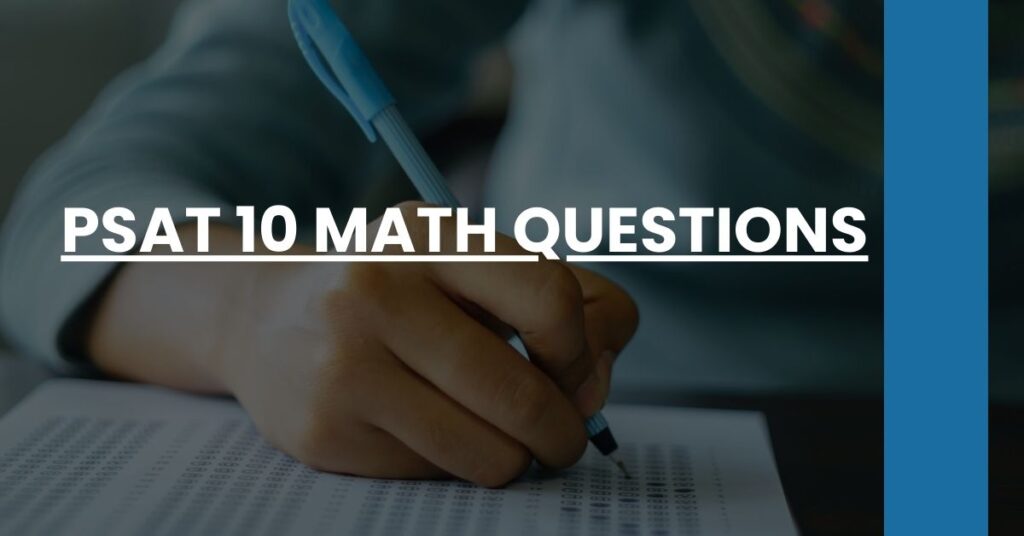Master PSAT 10 math questions with ease and score higher on your exam.
- Expert Strategies for PSAT 10 Math: Uncover top tactics to tackle math questions effectively.
- PSAT 10 Sample Questions: Work through curated practice questions that mimic the test.
- Test Preparation Resources: Access recommended materials for optimal PSAT 10 Math prep.
Conquer PSAT 10 math questions for a stellar test performance.
- Understanding the PSAT 10 Math Section
- Types of Math Questions on the PSAT 10
- Strategies for Approaching PSAT 10 Math Problems
- Reviewing Sample PSAT 10 Math Questions
- Tips for Preparing for the PSAT 10 Math Test
- Practice Tests by Concept
- Resources and Tools for PSAT 10 Math Success
- Conclusion: Next Steps After Mastering PSAT 10 Math
Understanding the PSAT 10 Math Section
Embarking on the journey of the PSAT 10 Math section is a pivotal step in any high school student’s academic career. This standardized test not only gauges your mathematical abilities but also lays the groundwork for future SAT tests and scholarship opportunities. Therefore, getting acquainted with its structure and content is crucial.
The Structure of the PSAT 10 Math Section
The PSAT 10 math segment is crafted to reflect the math competencies that are most relevant for college and career readiness. It comprises two main parts: one allows the use of a calculator, and the other doesn’t. In total, you are given 70 minutes to complete this section, which includes 48 questions.
Areas of Focus in PSAT 10 Math
The math questions are drawn from three primary content areas:
- Heart of Algebra: This area tests your mastery over linear equations, inequalities, and systems.
- Problem Solving and Data Analysis: Here, you’ll delve into quantitative insights, tackling problems related to proportions, percentages, and data interpretation.
- Advanced Math: This extends into the realm of complex equation solving and understanding the structure of expressions.
By understanding these areas, you are better equipped to strategize your study plan and polish the skills required to excel in the PSAT 10 Math.
For further insight into what topics you might encounter on the test, delve into the content outline provided by the College Board.
Types of Math Questions on the PSAT 10
As you prepare to conquer the PSAT 10 math questions, it’s beneficial to familiarize yourself with the types of math problems you’ll face. This section is meticulously designed to challenge and reflect on your mathematical prowess in a variety of contexts.
Common Question Categories
You can expect to see a blend of multiple-choice and student-produced responses, commonly known as grid-ins. The questions are usually presented in a context, requiring you to apply mathematical concepts to real-world scenarios. Here’s an outline of the type of questions based on the content areas:
- Algebraic Questions: These will test your ability to manipulate and solve equations.
- Real-World Problem Solving: Expect scenarios requiring analysis and application of data.
- Advanced Mathematics: Tailored to assess your understanding of higher-level math concepts like functions and polynomials.
Embrace these challenges with practice, and reflect on your problem-solving approach from various angles. For an in-depth look at question formats, visit the practice test section offered by the College Board.
Strategies for Approaching PSAT 10 Math Problems
Facing the PSAT 10 math questions can be daunting, but having a tactical approach can ease the process and enhance your performance. Let’s explore effective strategies to ensure you manage your time wisely and maximize your abilities.
Time Management Techniques
- Calculator Policy: Even though calculators are permitted in certain parts, getting comfortable solving problems without one can save precious time.
- Skip and Return: Difficult questions are time-consuming. Skip them initially and revisit once you’ve tackled the easier ones.
Answering Tips
- Elimination: Narrow down your choices. If you can eliminate even one option, guessing becomes statistically advantageous.
- Grid-Ins: For student-response questions, ensure your answers are precise and properly formatted in the grid.
Remember, practice breeds familiarity and confidence. By regularly timing yourself while working through practice problems, you can develop a sense for the pacing that works best for you.
Reviewing Sample PSAT 10 Math Questions
To give you a concrete understanding of what to anticipate, let’s examine sample PSAT 10 math questions. Through this, you can visualize typical problems and get a sense of how to tackle them effectively.
Algebra: Linear Equations
- Sample Question: If 3(x – 2) + 1 = 10, what is the value of x?To solve: Distribute the 3 to both terms within the parentheses and subtract 1 from both sides to isolate the variable.
Data Analysis: Interpreting Graphs
- Sample Question: Refer to the line graph provided. Between which two years did the sales of Company X increase the most?To analyze: Compare the slopes of the line segments between successive years to determine where the increase was steepest.
Advanced Math: Functions
- Sample Question: If f(x) = 5x + 3 and g(x) = x², find (f ∘ g)(2).To compute: First, find g(2), which is 2 squared, and then apply the result to the function f(x).
By deconstructing these examples, you can apply similar principles to a variety of math problems on the test. To further reinforce your knowledge, access additional PSAT practice questions and answers to expand your practice repertoire.
Tips for Preparing for the PSAT 10 Math Test
Embarking on your PSAT 10 Math test preparation can be a smooth journey with the right strategies in place. Like a trained athlete preparing for a marathon, you need to nurture your strengths and address your weaknesses intelligently to achieve peak performance.
Crafting a Study Plan
- Assess Your Starting Point: Begin by taking a diagnostic test to identify areas that require more attention.
- Allocate Study Time: Divide your study time between reviewing concepts, practicing psat 10 math questions, and taking full-length practice tests to simulate the test day experience.
- Regular Review Sessions: Space out your study sessions for better retention of mathematical concepts and strategies.
Leveraging Quality Study Materials
- Recommended Books: Seek out highly-rated PSAT prep books that offer comprehensive reviews and ample practice problems.
- Online Resources: Utilize reputable online platforms that provide structured lessons and interactive practice.
- PSAT Prep Apps: Consider apps that offer daily practice questions to keep your skills sharp.
Practice, Practice, Practice
- Dive into Practice Tests: Engage regularly with practice tests to acclimate to the format and time constraints of the PSAT 10.
- Analyze Your Mistakes: Each incorrect answer on a practice test is a learning opportunity; understand where you went wrong and how to correct it.
- Mix Up Question Types: Ensure you’re comfortable with all types of psat 10 math questions by integrating a range of problems into your study sessions.
Practice Tests by Concept
To further refine your preparation for the PSAT 10 Math section, concept-specific practice tests can provide a targeted review that caters to your unique areas for improvement.
Focusing on Algebra
- Simplify Your Approach: Tackle the most commonly tested algebraic concepts before progressing to more complex problems.
- Factor in Variety: Practice with both straightforward equations and word problems that require the application of algebraic rules.
Data Analysis Drills
- Statistical Reasoning: Sharpen your ability to interpret graphs, charts, and tables often featured in psat 10 math questions.
- Practice Percentage Calculations: Fortify your skills in calculating percentages, a fundamental aspect of data analysis.
Honing Advanced Mathematical Skills
- Function Fundamentals: Ensure you are comfortable with functions, as they often serve as the basis for more advanced psat 10 math questions.
- Polynomial Proficiency: Review polynomial expressions and their properties, giving special attention to factoring and solving polynomial equations.
Incorporating these practice tests by concept into your study regimen can help secure your confidence and capability in each math domain.
Resources and Tools for PSAT 10 Math Success
A bevy of resources is available at your disposal, each designed to optimize your PSAT 10 Math test preparations. However, discerning which tools are the most effective can be the key to unlocking your potential.
Online Practice and Instruction
- The College Board’s Official Resources: Utilize the official PSAT practice tests to experience questions resembling those on the actual test.
- Targeted Video Lessons: Khan Academy’s SAT practice resources focus on specific skills necessary for conquering psat 10 math questions.
Printed Prep Books and Guides
- Comprehensive Study Guides: Look for books that include thorough content reviews along with practice questions and answer explanations.
- Problem-Solving Workbooks: Regularly working through math workbooks can bolster your ability to navigate various problem types.
Community and Support
- Study Groups: Join or form study groups with peers to discuss strategies and solutions to challenging psat 10 math questions.
- Tutoring Services: Consider engaging a tutor for personalized instruction tailored to reinforce your math proficiency.
By judiciously utilizing these resources and tools, you can ensure your study sessions are both productive and targeted towards the PSAT 10 Math section’s demands.
Conclusion: Next Steps After Mastering PSAT 10 Math
Upon diligently following the outlined strategies and making use of the myriad of resources at your disposal, you will notice a newfound confidence in tackling psat 10 math questions. Your next steps involve maintaining momentum and continuing to build upon the robust foundation you have established. This pursuit of excellence in the PSAT 10 Math will not only assist you in this particular test but will also lay the groundwork for future academic endeavors in mathematics and related fields. Embrace the challenge with perseverance and a positive mindset, ensuring that you are primed for success when test day arrives.

